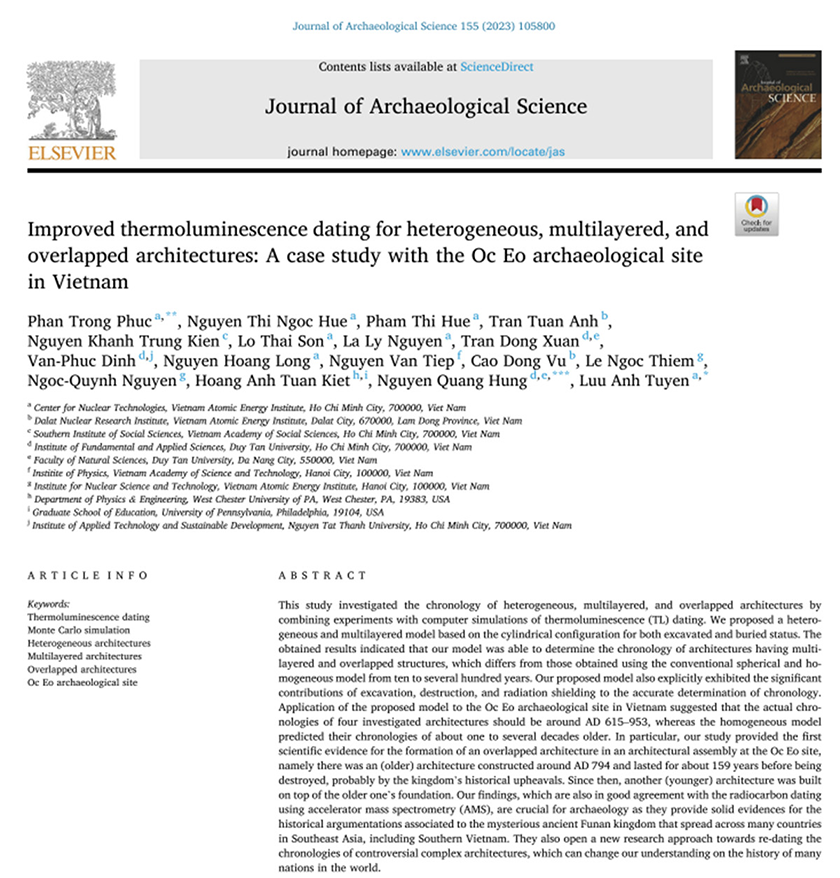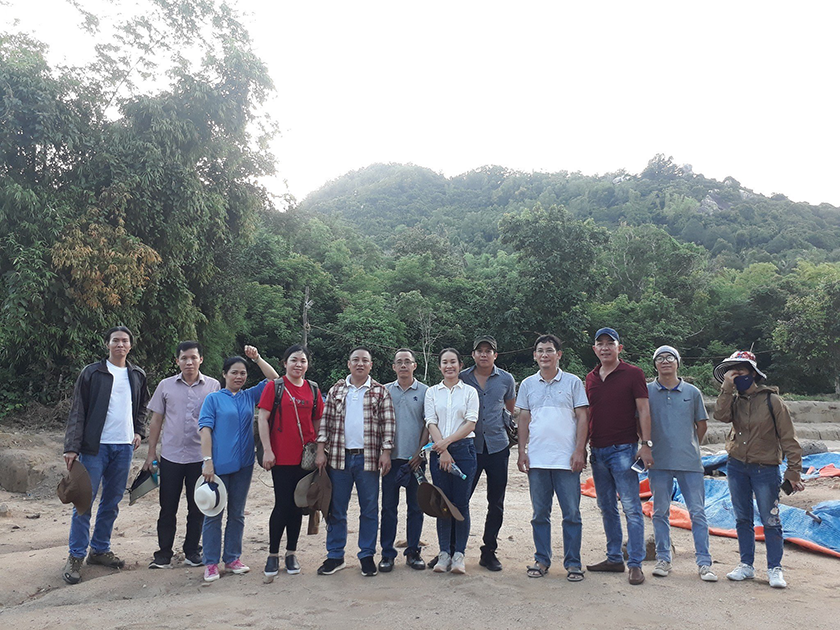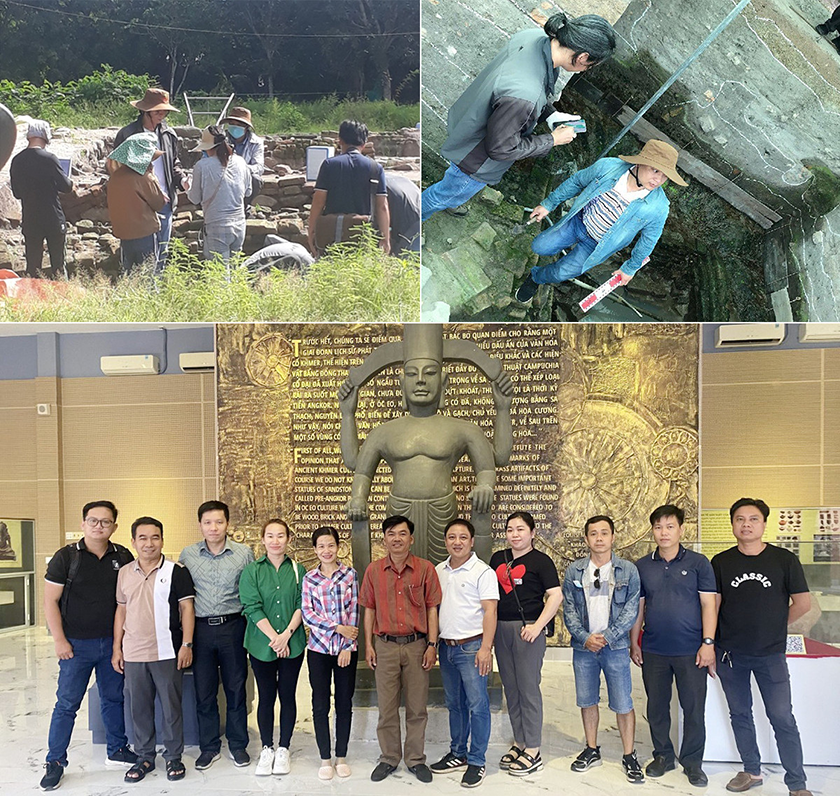
DTU publication in the Journal of Archaeological Science
The paper entitled: “Improved thermoluminescence dating for heterogeneous, multilayered and overlapped architectures: A case study at the Oc Eo archaeological site in Vietnam,” has just been published in the Journal of Archaeological Science (JAS).
JAS is one of Elsevier’s well-known ISI-indexed journals, ranked 5th out of the 322 Archaeological journals in the ScimagoJR database, at https://www.scimagojr.com/journalrank.php?category=3302.
“Although our research was normally strictly in the field of nuclear physics, the archeology and the chronology of monuments suddenly aroused my curiosity as a scientist,” said Associate Professor Nguyen Quang Hung, Head of the nuclear physics research group and IFAS Director. “Then, I immediately set up an interdisciplinary research group, worked to secure funding, including our own, to accurately date the sites at Oc Eo/Ba The. Our research team is interdisciplinary.”
-
IFAS DTU
-
The HCMC Center for Nuclear Techniques (CNT),
-
The Southern Institute of Social Sciences (SISS)
-
The Dalat Nuclear Research Institute (DNRI)
Previously, the most common method used was radiocarbon dating, which can only indirectly determine the age of the relics. It is difficult to collect organic samples from ancient structures, due to decomposition and human interference.
The traditional thermoluminescence (TL) method also gives a dating error of over 10%, especially when applied to heterogeneous, multilayered, overlapping brick or stone monuments, such as those at Oc Eo/Ba The. In the many other ancient structures around the world, this error could exceed 50%. Consequently, our team developed an improved TL method, based on a combination of experimental techniques and computer simulations.
“The method was pioneered by scientists at the CNT in 2010 and has been the subject of their research since then,” said Dr. Luu Anh Tuyen, leader of the group and head of the nuclear spectrometry research group at CNT. “From the experience accumulated in the application of the nuclear spectrometry t4 traditional TL method, by 2019, we had made some basic steps to improve the TL method. At that time, we assembled our team to perfect it and, for the past three
years, have been conducting some practical experiments at the ancient Oc Eo/Ba relic site.”

Group members on a field trip to Oc Eo/Ba in September 2020
At four architectural sites at the Sau Thuan knoll, part of the Oc Eo/Ba complex, they discovered that:
-
The construction date of the four structures was between 615 and 953 AD, in the early 7th to middle 10th centuries, with an error of less than 5%, which was finally well judged by the journal referees
-
The dating results were similar to those determined by the radiocarbon dating method, using a mass spectrometry accelerator (AMS) in Japan, based on organic samples found at the same location
For the first time, the Vietnamese team could chronologically distinguish between overlapping architectures. For example, a lower structure was dated 794 AD, while an upper one was built 159 years later.
According to Archaeological Center Director and SISS Deputy Director, Dr. Nguyen Khanh Trung Kien, “Dating the brick architectures of the Oc Eo culture used to be a challenge for archeologists, because the components used for radiocarbon dating, coal and wood, do not have a direct relationship with the brick structures. Furthermore, errors in the traditional TL method are far too high. Accurate dating with errors of less than 10% is very important archeologically. With errors ranging from 10% to 100% over several thousand years however, we cannot accurately understand the process chronologically, as each dynasty may have lasted from ten to a few hundred years. In this study, our team reduced the dating error to below 5% for the first time ever.
From the results of the project ‘Study of the Oc Eo/Ba The & Nen Chua relic site,’ led by the Vietnam Academy of Social Sciences, many of the brick buildings of the 5th and 6th centuries were identified and dated more accurately, including the various layers constructed at different stages, over the course of only 159 years. Based on our findings, archaeologists and historians will be able to more accurately determine the chronology of the Oc Eo/Ba The community and others. The agreement with the results of the Japanese AMS dating method confirms the reliability of our improved TL method, which can then be applied to the research of the architecture of the Oc Eo culture and elsewhere in Vietnam.”

Scientists at the Oc Eo/Ba The relic site
Head of the DNRI Research Department of Nuclear and Isotope Engineering, Dr. Tran Tuan Anh added, “Part of the work in this study comes from a project proposal to the Ministry of Science & Technology, which I led in 2020-2022. This project is in-line with the long-term research objectives of the DNRI and consists of two main components, the characterization of chemical elemental composition of materials and terracotta relicts, and dating the brick architectures at the Oc Eo/Ba The relic site. During the implementation, we used the strengths of each research team member to assign tasks but it proved very difficult to submit articles to JAS, negotiate with the referees, and then write repeated appeals to the journal. Finally our hard work was rewarded when the well-respected journal accepted the scientific and social significance of our research. Most importantly, this serves as a foundation for further studies into Vietnamese archeology, with continued investment from the DNRI and the development of a long-term relationship between IFAS, CNT and SISS.”
(Media Center)
The nuclear physics research group of the DTU Institute of Fundamental & Applied Sciences (IFAS) recently co-authored a new international paper in Archaeology.
















